Article Content
The beauty of a Purple Clay Teapot extends beyond the commonly discussed aspects of “clay, shape, craftsmanship, signature, and function,” to include its unique texture and color aesthetics that are exposed on its surface.
Pursuing the beauty of material color is the purpose for Tea enthusiasts when nurturing their Teapots.
After years of use, a purple clay Teapot develops a special “patina,” which is an embodiment of the beauty of its material's color.
The so-called “patina” refers to the deepening of the surface color over time and the formation of a matte finish, which becomes increasingly glossy with use. This matte finish is known as the “patina.” Even high-pressure washing cannot remove this “patina,” which instead highlights a refined aesthetic.

The “patina” of a purple clay teapot can be categorized into three types:
The first type forms from the natural aging and alteration of the clay itself.
The second type results from the repeated absorption and deposition of tea after long-term Steeping, where the tea seeps into the surface of the pot.
The third type is formed through constant handling, with the oils from one's hands penetrating the surface and creating a sheen through friction.
The first type of “patina” is an oxidized layer that forms when an object is exposed to air for a prolonged period. Any item can develop a “patina,” but not all “patinas” are visually appealing. However, the “patina” on a purple clay teapot is exceptionally beautiful. This is due not only to the characteristics of the clay but also because, despite being impermeable to water, the teapot allows for the passage of gases. As tea aromas permeate and escape, some elements within the clay seep out to the surface, and the longer this process occurs, the better the “patina” becomes. Different clays release different elements, resulting in distinct “patinas.” That is why old teapots have attractive “patinas,” and only good clay can produce a fine teapot. The formation of this “patina” can only occur over time; it cannot be rushed.
Experts say that old teapots should not be boiled or scrubbed to remove the “patina” and then re-nourished. Why? Because this type of “patina” is irreversible; the elements that can seep out have already done so, and there is no way to regenerate this “patina.”

The second type of “patina” is unique to teapots. This “patina” has a dual nature: one part is formed when tea water moistens the surface and seeps into the clay, while the other part forms when the inner walls absorb tea and it seeps outward. The principle of “nourishing the teapot with tea broth” is based on this. This “patina” is often misunderstood. Some believe that simply letting tea broth sit on the surface without wiping will form this “patina,” but what forms is actually tea residue, not the “patina.” Others think that pouring tea broth on the teapot will only create residue, not a “patina.” These misunderstandings arise from a lack of understanding of how this “patina” forms.
The third type of “patina” is commonly seen on other objects, such as wooden chairs becoming particularly smooth and shiny at the handholds from long-term use, or toys becoming exceptionally lustrous from constant handling. This is a “patina” formed by hand friction. With a purple clay teapot, long-term handling naturally produces this type of “patina.” Some refer to this “patina” as a “monk's shine,” which is a misnomer. What is a “monk's shine”? A “monk's shine” is the gloss produced by applying oily substances to the teapot's surface or having oily hands, which can be washed off. In contrast, the “patina” formed through long-term handling cannot be removed.

These three types of “patina” do not exist separately but rather blend together to form the unique “patina” of a purple clay teapot.
Of course, they can also exist independently. For example, if a teapot is made solely for display, it will only form the first type of “patina” due to surface oxidation. If it is handled regularly without steeping tea, it will form the third type of “patina.”
In essence, the “patina” is like the skin of the teapot, an integral part of the clay. It is not a film applied to the surface but something that cannot be removed by wiping.
Some people say that cloth should not be used to wipe the teapot, arguing that although it appears bright after wiping, it will become dull again if not used for some time.
If wiping with a cloth could make it appear bright, then nurturing the teapot would be too easy—simply continuous wiping would suffice. The purpose of wiping with a cloth is to remove tea residue and allow the “patina” to emerge, as well as to ensure that tea broth is evenly absorbed into the surface. If the teapot appears dull after a period of non-use, it is likely due to the formation of a new layer of oxidation or dust accumulation, which can be removed to restore brightness.

Nurturing the teapot is about nurturing its “patina.” To nurture a teapot properly means cultivating all three types of “patina.” Nurturing requires time and cannot be achieved overnight. It should be done calmly and naturally, allowing enjoyment to emerge spontaneously.